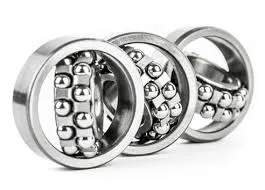
Nov . 11, 2024 03:01 Back to list
Creating Connections with Angular for Enhanced User Interaction
Angular Contact Bearings An Overview
Angular contact bearings are a crucial component in numerous applications across various industries, from automotive to aerospace. These specialized bearings are designed to accommodate axial loads in one direction while allowing radial loads, making them ideal for high-speed and high-load conditions.
Structure and Design
Angular contact bearings feature an internal ring designed to create an angle relative to the shaft, which distinguishes them from traditional radial bearings. The angle of contact is typically measured in degrees, with common configurations being 15, 25, or 40 degrees. This unique design allows these bearings to handle greater axial loads than standard radial bearings, making them suitable for applications that involve varying force directions.
One of the key structural elements of angular contact bearings is the arrangement of the rolling elements, typically balls or rollers, which are placed at an angle to the axis of rotation. This arrangement provides increased surface contact, enhancing load distribution and reducing stress on individual components. Furthermore, the inner and outer raceways are engineered to match the contact angle of the rolling elements, thereby optimizing performance and extending service life.
Types of Angular Contact Bearings
There are various types of angular contact bearings designed for specific applications
1. Single Row Angular Contact Bearings These bearings can support axial loads in one direction and are often used in pairs to accommodate bidirectional loads. 2. Double Row Angular Contact Bearings With two rows of rolling elements, these bearings can handle both axial and radial loads simultaneously, making them ideal for heavy-duty applications.
3. Four-Point Contact Bearings This type features a specific design that allows four points of contact, which can carry loads in both axial directions, thus enhancing versatility.
angular contact

Applications
Angular contact bearings are extensively used in several key industries
- Automotive Industry In vehicles, they support wheel hubs, transmissions, and differentials due to their ability to withstand high speeds and heavy loads. - Aerospace These bearings are employed in aircraft engines and landing gear systems, where reliability and performance are critical.
- Industrial Machinery Angular contact bearings are used in gearboxes, pumps, and conveyor systems, providing smooth operation and durability.
- Electronics They are found in precision equipment, where precision and minimal play are essential.
Benefits
The advantages of angular contact bearings are significant. They provide improved load-carrying capacity, increased rigidity, and enhanced operational efficiency. The design allows for high-speed rotation, which is essential in many modern applications. Additionally, they have lower friction compared to other bearing types, contributing to energy savings and extended service life.
Conclusion
In summary, angular contact bearings are an essential component in ensuring the reliability and efficiency of rotating machinery. Their unique design enables them to handle high axial and radial loads, making them suitable for a wide range of applications. As technology continues to advance, the importance of these bearings will only grow, underpinning innovations across various fields. Understanding the various types and applications of angular contact bearings is essential for engineers and designers working to create efficient and effective mechanical systems.
Latest news
-
Grooved Ball Bearing Design and Functionality
NewsJun.04,2025
-
Concrete Mixer Bearing Load Capacity Testing
NewsJun.04,2025
-
6004 Bearing Dimensions in Robotic Joint Designs
NewsJun.04,2025
-
Advantages of Single-Row Deep Groove Ball Bearings
NewsJun.04,2025
-
Applications of Deep Groove Ball Bearings in Automotive Systems
NewsJun.04,2025
-
Innovations in Bearing Pressing Machine Design
NewsJun.04,2025
